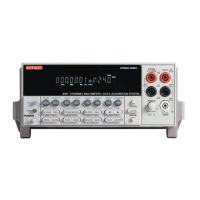Model 2701 User’s Manual Signal Processing Sequence and Data Flow D-5
Rel
Next in the signal processing sequence is the Rel operation. Rel is used to null offsets or
subtract a baseline rel value from the reading. With Rel enabled, the Rel’ed reading is
calculated as shown in Figure D-2.
NOTE For details on Rel operation, see “Relative,” page 5-2.
Math
Next in the signal processing sequence is a Math operation (mX+b, Percent, or
Reciprocal). These math operations allow you to mathematically manipulate the reading
(X) that is applied to this block in the flowchart. With one of the Math functions enabled,
the math result is calculated as shown in Figure D-2.
NOTE For details on Math operations, see “Math,” page 5-7.
Limits
The reading that is applied to the Limits block in the flow chart is not modified and is the
reading that is displayed on the Model 2701. With Limits enabled, the reading is tested
against two sets of high and low limits. Along with the displayed reading, annunciators
and messages are used to indicate the result of the limits testing.
NOTE For details on Limits testing, see “Limits,” page 9-2.
Buffer
With the buffer (data store) enabled, each displayed reading is stored and timestamped.
The buffer also provides statistics on the stored statistics. Buffer statistics include
minimum and maximum, peak-to-peak, average, and standard deviation.
When buffer recall is enabled, stored readings and the buffer statistics are displayed on the
Model 2701.
NOTE For details on the Buffer, see Section 6.

